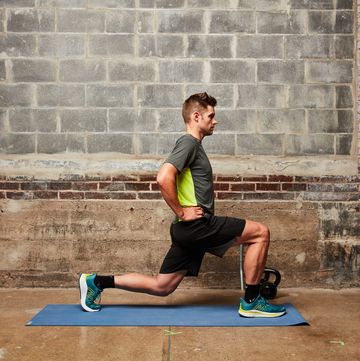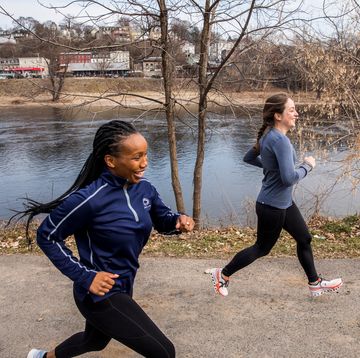You likely know that improving your stride calls for targeting three major lower-body muscle groups—quads, glutes, and hamstrings. But they’re not the only players in the game. Despite their smaller size, your calf and ankle muscles are just as important for improving stride and pushing pace.
Just think about how much you actually use those muscles. You activate them each time you stand or walk. When you run, your gastrocnemius and soleus—the muscles that make up most of your calf—produce the majority of that final push you need to propel upward and forward, says Paul DeVita, Ph.D., director of the Biomechanics Laboratory at East Carolina University in Greenville, North Carolina. And that thrust partially determines your pace and stride length. Which means ignoring those muscles can slow you down, and worse, contribute to a higher risk of injury.
Scientists have some idea of why this may happen. A recent Finnish study hooked runners up to 3-D motion-capture systems and found that the overall effort required of the calf muscles was actually 25 percent greater than that of the quads. That makes them more prone to fatigue over a long run or race, pumping the brakes on your pace.
DeVita also found that ankle and calf muscles tend to change and atrophy as we age. He tested the biomechanics in runners as young as 20 and as old as 60, and found that older runners had about one-fifth to one-third less ankle power—which correlated with a 10 percent slower pace and shorter stride.
RELATED: 5 Things No One Tells You About Running as You Get Older
Runners can slow down this muscle decline with exercise that improves calf function and their ability to produce force, says Max Paquette, Ph.D., assistant professor of biomechanics at the University of Memphis. Which means it’s never too late to start showing those smaller muscles a hefty amount of love.
Try this foam rolling routine to help your calves recover after a run:
And no, you shouldn’t simply run more or faster to try to reap the strengthening rewards. Paquette says doing so can boost your injury risk, especially if your body isn’t trained to handle the increase. Instead, incorporate these routines he designed into your schedule two or three times a week. Each exercise will help protect your leg muscles as you dial up the volume or intensity of your training.
Warm Up
Before you run, do these exercises as part of a dynamic warmup.
Forward Skips
Skip, bringing your front knee to waist height and your opposite arm forward. Keep your back leg straight and focus on pushing off and landing on your toes, always engaging the calves. Continue for about 100 feet, walk back, and repeat twice for a total of 3 sets of skips.
High Skips
Repeat the same motion as a forward skip, but explode upward each time your foot leaves the ground. Continue for about 100 feet, walk back, and repeat twice for a total of 3 sets of skips.
Toe Jumps
Stand with feet hip-width apart; rise to the balls of your feet. Keeping knees stiff (but not locked), quickly hop up and down. Do 3 sets of 20 jumps.
More advanced: Stand on your right leg with left leg bent behind you. Hop on your right leg. Do 5 jumps and switch legs for 1 set. Do 3 sets.
Double-Leg Box Jumps
Stand with feet hip-width apart; rise to the balls of your feet. Jump clockwise in a box shape—first about a foot forward, then to the right, then backward, then to the left. Repeat 5 times. Reverse direction and repeat for 1 set. Do 3 sets.
Strength-Train
Perform these moves two or three times per week to build stability and strength.
Lunges with Calf Raises
Stand with feet hip-width apart. Step forward with your right leg and lower into a lunge. Lift and lower your right heel for 10 to 12 reps, keeping your spine straight and weight over your big toe. Push off your front foot to return to standing. Switch legs and repeat for 1 set. Do 3 or 4 sets.
RELATED: Get stronger, faster, and stay on the road with the New IronStrength Workout from Runner’s World.
Seated Calf Raises
Sit on a bench or chair, resting the balls of your feet on a block about 12 inches in front of you. Place a weight plate, dumbbells, or a heavy object (like a box with books in it) on your thighs, about 3 inches above your knees. Lift your heels as high as possible, squeezing your calves. Slowly drop your heels as low as possible, until you feel a stretch in your calves. Do 10 to 12 reps for 1 set. Do 3 or 4 sets.
More advanced: While seated, shift the weight to your right thigh and place your left foot on the floor. Repeat the same exercise, raising and lowering right heel. Do 10 to 12 reps; switch legs and repeat for 1 set. Do 3 or 4 sets.
Calf Raises
Stand on the edge of a step, letting your heels hang slightly lower than your toes. (If you’re a first-timer, ease into this exercise by standing on the edge of a slanted surface, like a raised wood plank.) Rise onto the balls of your feet, engaging your calves. Keeping knees straight but not locked, lower down until you feel a stretch in your calves. Do 10 to 12 reps for 1 set. Do 3 or 4 sets. For an added challenge, hold a dumbbell in one or both hands.
More advanced: Stand on your right leg with your left leg bent (there should be no weight on it). Repeat the same exercise as above. Do 10 to 12 reps; switch legs and repeat for 1 set. Do 3 or 4 sets.
Toe Walks
Stand with feet hip-width apart; rise to the balls of your feet. Walk forward 30 feet, about the width of a tennis court. (Or walk in a circle for 30 seconds.) Relax for a few seconds, then turn around and repeat in other direction. To make it harder, carry a dumbbell in each hand. Repeat 3 or 4 times.

Cindy is a freelance health and fitness writer, author, and podcaster who’s contributed regularly to Runner’s World since 2013. She’s the coauthor of both Breakthrough Women’s Running: Dream Big and Train Smart and Rebound: Train Your Mind to Bounce Back Stronger from Sports Injuries, a book about the psychology of sports injury from Bloomsbury Sport. Cindy specializes in covering injury prevention and recovery, everyday athletes accomplishing extraordinary things, and the active community in her beloved Chicago, where winter forges deep bonds between those brave enough to train through it.













